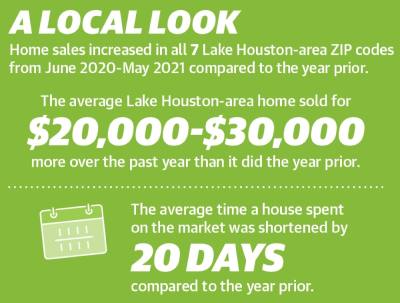Over the past two years, the number of listings in the Houston-The Woodlands-Sugar Land area has been slashed by more than half, according to data from the Texas A&M University Texas Real Estate Center. Simultaneously, home sales increased by over 10% from May 2019 to May 2021—a trend industry experts attributed to low mortgage interest rates, which dropped to 2.65% in January.
As a result, the Greater Houston area sat at 1.4 months of housing inventory in April and May—the area’s lowest inventory since the center began tracking data in 1990. Months of inventory indicates the number of months it would take to sell all properties currently for sale at the average monthly sales price.
“It’s kind of the perfect storm,” said Walter Draughn, a Highland Homes sales counselor for The Groves. “It’s never all come together like this—one or two things at a time, yes—but not all at once.”
Locally, home sales increased in all seven Lake Houston-area ZIP codes from June 2020-May 2021 compared to the year prior, according to Houston Association of Realtors data. Additionally, the average home sold for $20,000-$30,000 more over the past year than it did the year prior, and the average time spent on the market was shortened by 20 days.
“There’s no question it’s a seller’s market; you can’t spin it any other way,” said Deborah Rose Miller, a broker/agent with Rose Realty and HAR’s 2021 Lake Houston-area networking meeting chair.
Further fueling the fire, Draughn said about one-third of all relocations in the U.S. are coming to Texas. As a result, builders are trying to keep up with a growing demand for inventory amid material shortages that bog down the process.
Supply and demand
Due to a rise in demand for construction materials, 84% of contractors nationwide have faced supply shortages, and 94% said cost fluctuations have affected their businesses, according to the U.S. Chamber of Commerce’s quarterly Commercial Construction Index report released June 17.
“People had nothing better to do [during COVID-19] than stay home and decide they want to buy a new house or remodel,” said Mike Dishberger, CEO of Houston-based Sandcastle Homes and former Greater Houston Builders Association president. “So demand has exceeded supply, and when that happens, prices rise.”
For example, Dishberger said plywood cost $7 per sheet in April 2020 and was up to $50 per sheet this June. A recent copper shortage increased the price of his electrical materials by 25%, he added.
Similarly, Draughn said brick that Highland Homes used to buy for $2,000 now costs upward of $6,000. He said construction on one of his inventory homes in The Groves, a 993-acre community under development in Humble, has been delayed by two months due to tile unavailability.
“It’s definitely slowed us down,” he said. “We used to do contract to move in, in less than four months; we’re at six to eight months now.”
In hopes of providing consistent customer service, Draughn said Highland Homes has limited the number of homes he can sell to three per month.
“It’s gotten so hard to get [laborers] and materials ... that if we kept selling at the pace we were selling, we were going to overcommit and not be able to deliver the Highland [Homes] experience,” he said. “So we made the decision to pull back.”
Additionally, Draughn said many builders are implementing escalation clauses, which specify if building materials increase by a certain percentage, the homebuyer will be responsible for paying the higher cost. However, Draughn said Highland Homes is not one of those builders.
“When somebody buys a house, that’s a big purchase, and we want to give them something they can depend on, so we’ve eaten the cost,” he said.
However, Rose Miller said the rising cost of new homes has breathed new life into resales.
“Existing houses have been able to complete with new construction because the new construction for the same floor plan is so much higher,” she said.
Cost of living
Industry experts have historically touted the Greater Houston area as one of the most affordable places to live nationwide. However, Draughn said with so many people looking to move to the area, builders have been unable to keep up.
“The housing market has been underbuilt by close to 400,000 units a year for the past 14 years,” he said. “If all major builders increased their sales and production by 10%, it would still take about eight or nine years to hit equilibrium. But that’s nationwide. ... It’s two to three times worse [here].”
However, Draughn said the local real estate market is still less pressured and costly than other major Texas markets, such as Austin, where Draughn said a neighborhood with 40-50 available houses garners a waiting list of 350-400 potential buyers.
“We sell the same house in Austin for $100,000-$150,000 more just because land, materials and labor cost that much more there,” he said.
Because consumer demand is the driving force behind escalated price tags, Rose Miller said she suspects the new cost of living is here to stay.
“It’s like a rubber band; it stretches, and there may be some adjustment, but it won’t go back to how it was,” she said.
Danica Lloyd contributed to this report.







